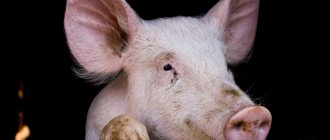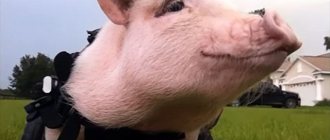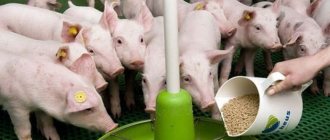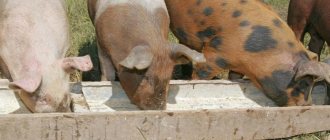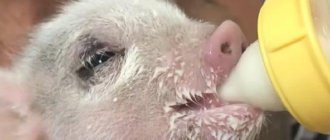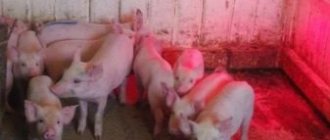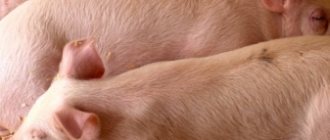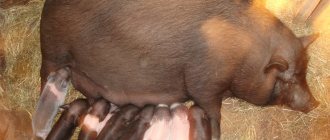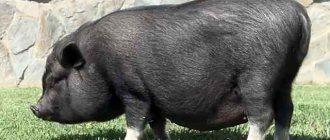The role of hybridization and interbreeding in pork production.
Hybridization (or crossing) of animals of different breeds leads to a number of effects, in which the first generation hybrids exhibit the appearance of properties that their parents did not have, or to a stronger manifestation of certain parental qualities.
Hybrid crossing has been used in pig production for a very long time. It was thanks to long-term interbreed hybridization, as well as inbreeding - inbreeding, carried out to consolidate certain genetic qualities, that new modern breeds of pigs were developed.
The reason for the manifestation of heterosis still remains poorly understood. However, we can state the fact that animals obtained from crossing two or even three breeds have qualities that are unusual for their ancestors. Heterotic hybrids are more resistant to diseases, they demonstrate a high growth rate, require less feed to obtain a unit of weight gain, and have greater fertility.
This effect is not associated only with purely external manifestations, when hybrids differ from their parents in larger size; it also has a number of features fixed at the molecular level - features of the course of certain biochemical processes, increased activity of individual enzymes. In all these cases, the resulting effects are explained by the high heterozygosity of the new individual.
Hybridization in pig farming is the basis of breeding work carried out in this industry, ensuring high profitability of pork production. It is no coincidence that in countries that are world leaders, hybrids make up up to 90% of the main pig population, while the same figure in Russia is no more than 50%. Modern pig farming is based on the competent organization of selection and breeding work.
However, for heterosis to manifest itself, simply crossing pigs of two different breeds is not enough. Breeding work is always long-term, based only on data obtained experimentally, so it is very difficult to theoretically predict the effect that can be obtained from interbreeding. Existing hybridization schemes in pig farming provide for a two or three-stage system for producing heterotic hybrids.
Depending on the effect to be obtained, there are three forms of manifestation of heterosis. In the first case, animals are superior to the parent generation in terms of constitutional characteristics and vitality; in the second case, they occupy an intermediate position between their parents, but are characterized by increased fertility; and in the third case, while maintaining high external indicators, they completely lose the ability to reproduce.
For example, to obtain animals for fattening (with high growth rates and feed conversion), sows of tallow or meat-fat breeds are crossed with boars of pure meat breeds. The resulting hybrids gain slaughter weight 15-20% faster, have better carcass characteristics, and require lower feeding costs.
Crossing large white breed sows with Estonian bacon or Poltava meat breed boars leads to an increase in the number of piglets produced by 1-3 per farrowing and better survival of the young. At the time of weaning, young animals of two-breed hybrids have a greater body weight than with purebred crossing, thus, such animals are more compliant with the requirements of large-scale complex technology than their purebred counterparts.
Using hybridization, it is possible to improve the quality of the resulting pork. By crossing Great White breed sows and meat breed boars in a three-stage hybridization scheme, you can achieve an increase in carcass meat, obtain leaner and denser meat, the protein content of which will be 3-5% higher compared to other breeds of pigs. This feature is taken into account when producing pork for special purposes, for example, for the production of kumpyak or dried products.
The offspring resulting from hybridization are often infertile, and second-generation hybrids no longer have the same qualities as their parents. The effect of heterosis fades in each subsequent generation, however, some modern breeds of pigs allow it to be preserved up to 4-5 generations. Animals obtained from interbreeding are most often intended only for fattening and are not used in the reproduction of the main herd.
Proper organization of breeding work, the use of interbreed hybridization and the heterosis effect in pig farming can increase the profitability of pork production by 10-15% without additional costs for feed and treatment of animals.
Production planning system for the reproduction of fattening pigs
The organization of reproduction of a herd of pigs means a rational system for the use of boars and sows: preparing them for mating (insemination), proper planning and carrying out matings (artificial insemination) and farrowing, adequate feeding and satisfactory maintenance of the queens during all periods of their production cycle, proper rearing of young animals and ensuring its safety.
To increase the number of pigs, including fattening ones, it is important to take measures to preserve and raise piglets, increase the number of farrows per queen and improve the structure of the herd.
Herd structure. The structure of the herd is understood as the ratio in the herd of pigs of various technological groups, boars, main and tested (repair or one-time) queens, suckling piglets, weaned piglets, replacement young animals and fattening pigs. The structure of the pig herd on a farm or complex can vary significantly depending on specific economic conditions and the specialization of the enterprise.
It should be borne in mind that the herd structure adopted on the farm must ensure the planned reproduction of the livestock and a certain volume of pork production.
Boars (main and test) - used for mating with queens or obtaining semen during artificial insemination of pigs.
Basic sows are a group of the most productive adult animals (necessarily purebred in breeding farms or crossbreds in commercial farms), whose productivity was assessed by at least one farrow.
The number of main queens on a farm is determined by the capacity of the enterprise, i.e. the number of young animals necessary to fulfill the production program of a farm or complex. When organizing efficient production at a pig-breeding enterprise, the optimal duration of use of sows is 5.5 farrows.
The sows tested are a group of young sows, usually after the first farrowing and before the piglets are weaned. During round farrowing, gilts obtained from the main queens are isolated mainly during the winter-spring farrowing period. They occur at 9-10 months of age with a live weight of at least 110-120 kg. In farms with traditional technology, test queens can be farrowed in summer camps using lighter, cheaper housing and green pasture feed.
Repair pigs. In breeding farms, this group includes winter-spring farrowing gilts from breeding core queens. It is important that the number of gilts retained for repair is 2-3 times greater than the number of sows culled annually. This will allow for more careful selection of gilts during their growth period and in terms of first farrowing performance.
It is advisable to select a pig for later raising into a good sow from the queens of the breed that is bred in a given climatic zone, preferably from winter or early spring farrowings. It must come from a multiparous sow and be well developed. Particular attention must be paid to the number of nipples (there should be at least 12) and the bite. You cannot remove a pig from a nest where there are crooked, pug-shaped piglets or from a uterus with cratered nipples.
Weaned piglets. This group includes piglets after weaning them from their mothers. Age - over 60 days, and in case of early weaning - from 26-36 days until they are put on fattening at 3 months of age, depending on the technology adopted at a particular enterprise.
Planning of matings and farrowings. The timing of mating (insemination) of animals and farrowing is established based on farm conditions and the adopted production technology. In this case it is necessary:
- draw up an annual plan for mating (insemination) of animals and the use of each pig barn 4 months before the start of the calendar year;
- determine the capacity (number of pens) of each pig barn;
- establish calendar dates for insemination of successive groups of sows, taking into account the fact that their number during mating should be 25% (idle level), and before farrowing should be 10% higher than the number of pens in the queen cell
- determine the priority and calendar dates (in accordance with the production regime) for the release of pig barns from the livestock that are currently in them;
- establish calendar dates for disinfection and readiness of queen cells to receive the next groups of pregnant queens 7-10 days before farrowing;
- take a break, the duration of which is equal to the number of missing premises multiplied by the rhythm in days (the duration of the formation of a group of suckling sows) or a production step, with an incomplete set of premises (sections) between production rhythms. For example, a farm has a 14-day rhythm and there are six rooms instead of eight, so the break should be equal to (14x2) 28 days;
- empty and fill pig barns simultaneously according to the principle “everything is free - everything is occupied.”
The intensity of use of sows varies depending on the reproductive cycle. The reproductive cycle refers to the number of days from one fertilization of the uterus to the next after weaning of the piglets, including the duration of gestation (114-116 days), the suckling period (26-56 days) and the time of insemination of the uterus after weaning the piglets (7-49 days).
The shorter the reproductive cycle, the more farrows a queen can produce per year. The reproduction cycle can only be shortened by weaning piglets earlier.
Short cycle - 114 (pregnancy) + 26 (suction) + 7 (period before insemination) = 147 days
Long cycle - respectively 116 +56 +49 = 221 days
In specialized farms with well-equipped premises for keeping queens and raising piglets, farrowing is carried out throughout the year. To do this, in accordance with the technological process adopted on the farm, a group of queens is artificially inseminated daily or after a certain number of days, which ensures the sequence of all other production processes (farrowing, weaning and growing piglets, transferring them to fattening).
Insemination (mating) of sows should be carried out as soon as possible to ensure the production of compacted, so-called round farrowings. With such farrowing, the farm receives more even young stock for distribution into groups and for subsequent fattening, which contributes to better organization of young stock rearing, increased labor productivity, resulting in a reduction in production costs.
Before each round of farrowing, the pigsty is thoroughly cleaned and disinfected, which ensures normal veterinary and sanitary conditions in the premises. In the southern regions of the country, it is also advisable to use lighter type premises for spring-summer farrowing.
When drawing up a plan for matings and farrowings, it is planned to receive two farrows from the main queens, and one farrow from the tested queens per year. Based on the farm's accepted farrowing dates and the duration of gestation, the time for insemination or mating of sows is determined.
Thus, during round production to produce piglets in winter and early spring, mating of queens is carried out in October-November, and during late spring farrowing - in January-February.
Use of boars and sows. When kept in groups, boars already at 5-6 months of age exhibit sexual reflexes and can fertilize sows. However, breeding use of boars begins, as a rule, at the age of 10-11 months with their overall development not lower than class I. Early use of sires leads to stunted growth and small litters. At the same time, introducing one cage per month to boars from the age of 8 months promotes their more correct development and prevents the occurrence of sexual perversions.
Typically, breeding boars are used until 4-5 years of age. At least 25% of producers are subject to annual rejection. To replace them, 50-100% (of the number of breeders) of replacement boars are selected. The best animals, after production testing, are transferred to the main herd (usually at the age of 2 years).
The mixed-age composition of breeding boars allows them to be used correctly. The best results are obtained when full-aged gilts are mated with young boars, and young sows with sires aged 3-5 years (Table 48).
The efficiency of using boars and their productivity are greatly influenced not only by the breed, but also by the conditions of feeding, care, maintenance, mode of use, insemination technique, etc.
With a seasonal farrowing system, boars must have their sperm quality checked 1-1.5 months before breeding. In accordance with the obtained indicators, producers are prescribed feeding, care and maintenance in order to improve sperm quality.
With a conveyor (flow) farrowing system, boars are used evenly throughout the year. In this case, constant monitoring of the physiological state of the producers and the quality of sperm is necessary.
Boars that do not currently meet the requirements for breeding use are provided with improved conditions of feeding, care and maintenance for a period of at least one month, after which they are re-tested. If there is no deterioration in the controlled indicators or it is insignificant, then the animals are put under further control or rejected. If, after 2-3 checks, there are no significant signs of improvement in reproductive functions, even boars that are especially valuable in breeding terms are discarded and replaced with young sires tested for the quality of their offspring.
The rearing of replacement gilts should be carried out in such a way that by the time they enter the reproduction workshop they are all sexually mature, i.e. came into heat in the last months of growing. Feeding of sows at the complex should be such that they are neither obese nor emaciated in all phases of production use. An important point that influences the arrival of sows into heat after weaning piglets is the rate of feeding them during the weaning period. 2 days before weaning, the feeding rate should be reduced by 2 times; on the day of weaning, do not feed at all.
On the 2nd day of weaning, the feeding rate should be only 50% of the daily value, and only on the 3rd day is feeding brought up to normal. Typically, most sows come into heat 4-5 days after weaning their piglets, but some of them come into heat earlier, others later. Therefore, heat detection using a test boar should be carried out from the first day after weaning piglets; in addition, the test boar stimulates other queens. It is necessary to analyze the level of feeding of sows not only by the overall nutritional value of the diet, but also by the content of vitamins and minerals in the feed and, if necessary, adjust feeding.
Stimulation of sexual heat in replacement gilts. The main condition for the formation and manifestation of physiologically normal reproductive function in animals is adequate feeding and optimal living conditions in accordance with the above recommendations.
In addition, when pigs reach 6 months of age, in order to stimulate puberty, special techniques such as dosed contact with boars, pheromone treatment or injections of gonadotropic hormones are used.
An analysis of sexual cyclicity and the quality of detection of estrus in pigs showed that within 7-10 days after weaning of piglets, estrus appears in 80-90% of the queens. Moreover, among the single queens there will be animals with technologically early weaning of piglets, due to low fertility, shortened lactation (agalactia), loss of piglets in the first days after birth, etc. Such queens go into heat at unpredictable times. In addition, it is undesirable for women to come into heat before the 15-20th day after farrowing (due to their low fertility and multiple births). Therefore, queens that come into heat are not inseminated until 15 days after farrowing, but the date of the missed heat is indicated on the container and in the production card. Due to missed heat, the interval from weaning to insemination in such queens will be more than 30 days.
The average time interval for replacement gilts of breeding age and weight with normal sexual cyclicity should be from the moment single and conditionally pregnant queens arrive at the site until hunting (mating, insemination) 10 days (half the duration of the sexual cycle). However, practical results show that from 20 to 30% of replacement gilts by this time do not come into heat or do not show it noticeably enough, so it is necessary to increase the time interval before hunting (mating, insemination) to 21-22 days. In addition, due to the increased empty space after the first mating (insemination) of replacement gilts, it is necessary to increase the period of their maintenance by 2 times.
Thus, the average duration of the period from arrival at the reproduction workshop to fertilization for queens will be 21 days (including idle time after the first insemination), for replacement gilts - 42 days.
Fertilization of pigs on farms and complexes should be carried out by artificial insemination, and only in individual farms (breeding farms and low-capacity farms) the use of manual mating of pigs is allowed. Sperm is obtained directly on the farm or purchased at inter-farm or inter-district artificial insemination stations.
Detection of heat in single queens and replacement gilts of breeding age, as well as in inseminated queens (detection of singleness) is carried out twice a day using test boars.
It is planned to inseminate animals twice in one hunt. The dose of semen is 100-150 ml containing 3-4 billion sperm cells with rectilinear forward motion (1 ml of diluted sperm should contain at least 30 million sperm cells with rectilinear motion).
Queens and gilts are inseminated according to a differentiated time schedule. For this purpose, there should be a container above each machine for storing production cards and recording on it operational information about the physiological state of the animals. Records on containers must be made in the same type (unified). In group pens for keeping single queens and gilts, the date of receipt of the animals (weaning date) is recorded. In individual pens - animal number (tag or ear number), date of insemination. Under the date of insemination, the number of the boar whose semen was used to inseminate the uterus is recorded.
During the first half of the working day, the first detection of heat in pigs and repeated insemination (mating) of queens detected in heat on the previous day are carried out. In the second half of the working day, the second detection of heat and the first insemination (mating) of pigs identified in heat in the morning of the current day are carried out, as well as mating (insemination) of queens identified in heat in the second half of the working day. This mode of mating (insemination) of pigs allows you to regularly distribute the load on operators over both halves of the working day and obtain high fertility of queens and gilts.
Diagnosis of pregnancy. Before transferring pregnant uteruses to the section, it is necessary to identify single animals. To determine pregnancy in the period 30-60 days after mating (insemination) of the queens, an ultrasonic portable device is used
Farrowing. 2-4 days before farrowing, feeding rates are reduced by approximately 30-40%, and the amount of all feed in the diet is reduced. The last two days before farrowing, the queens are fed liquid mash. Pigs should be given water at the temperature of the pigsty.
In the last days before farrowing, the queen's udder greatly enlarges, turns red and droops. The queen is worried, often lies down and collects straw. The outside of her genitals become red and swollen. Before farrowing begins, it is necessary to prepare clean burlap, scissors, iodine, and threads for receiving the piglets.
Farrowing of sows is carried out in special pig barns. The farrowing room must be dry and warm. Keeping piglets in damp, poorly equipped pigsties leads to their illness and death. Before placing the queens, the pens are disinfected. The air temperature in pig barns must be maintained within 16-24°C, and relative humidity - 70-75%. When farrowing is carried out on a farm all year round, pigsties are built with automatic microclimate regulation.
In pens for queens, barriers made of metal pipes are installed along three walls. The installation of such barriers at a distance of 25-30 cm from the floor and wall protects the piglets from being crushed by the queen when she lies down. The piglet compartment is generously covered with bedding, which is changed as it gets dirty.
On many pig farms, next to the pens for the sow, there are small compartments (boxes) with a manhole for piglets, equipped with electric heaters that automatically regulate the temperature within 28-32 ° C, as well as equipment for ultraviolet irradiation; troughs for feeding piglets are installed here.
Farrowing lasts about 2 hours, but sometimes it takes longer. For a newly born piglet, the nose and mouth are cleared of mucus, then the umbilical cord is tied and cut at a distance of 4-6 cm from the belly; the end of the umbilical cord is disinfected with iodine solution. If ligation of the umbilical cord is not used, then after trimming it is necessary to squeeze it tightly with your fingers until the bleeding stops and moisten it with iodine. The piglet is wiped dry with a clean burlap or towel and allowed to suckle no later than 30 minutes to the uterus. In breeding farms, born piglets are weighed.
On large pig farms and complexes, a feed compartment is allocated in the pens of the pig barn for feeding the queen; in the middle of another part of such pens there is a cage for the fixed maintenance of the uterus during farrowing and in the first period of growth of piglets. The side compartments of this compartment are intended for piglets. Here, in addition to teat drinkers and feeders for piglets, there are installations for electric heating, which automatically regulates the temperature, and ultraviolet irradiation.
The device for fixing the queens limits their movements, which ensures the safety of the piglets at birth. Therefore, farrowing can take place in the absence of maintenance personnel (operator). The born piglets crawl under the electric heater, and the umbilical cord breaks.
After farrowing, the operator processes and disinfects the umbilical cord, assigns an inventory number to the piglet and records information about farrowing in a special accounting card.
The end of farrowing is judged by the release of the placenta, which is immediately removed from the pen to avoid being eaten by the queen, which prevents her from subsequently eating the piglets. After farrowing, contaminated areas on the body of the uterus are washed with warm water and wiped, and the bedding in the pen is changed.
Improper feeding of queens, leading to their obesity, or feeding that is not balanced in the content of vitamins, minerals, especially calcium, as well as the inclusion of spoiled feed in the diet and lack of walks during pregnancy can lead to the birth of dead piglets.
If the number of piglets born does not exceed the number of normally developed nipples in the uterus, the entire litter is allowed to suckle at the same time, and from the very first day the piglets are accustomed to certain nipples. The amount of milk in individual teats of the udder varies among sows. The front lobes of the udder are usually better developed and milkier. Therefore, weaker piglets are placed on the front teats, and stronger piglets on the rear teats. Piglets born first are usually more vital and better developed than piglets born later in the farrowing period.
If the number of piglets born exceeds the number of teats the queen has, then some of them are placed with another queen that has given birth to fewer piglets than she has teats. To prevent the queen from smelling the difference between the piglets placed next to her and her own, all piglets are sprayed with some strong-smelling substance (a weak solution of creolin, carbolic acid). After this, they are allowed to approach the uterus.
In pig farms and complexes, with a daily, 3-7 or 14-day rhythm, depending on the capacity of a given enterprise, farrowing from 33 queens is received from three insufficiently multiple piglets, all piglets are taken away and placed with other queens. When the movement of the queens fixed in the cage is limited, the transfer of other people's piglets is simplified, since the queen cannot cause traumatic damage to them. After weaning the piglets, the queens are transferred to the workshop for insemination and maintenance of queens of the first period of gestation.
Crossbreeding in pig farming
These are students of the animal engineering faculty of St. Petersburg State University. The conducted research gives positive results and is successfully used in production.
The first batch of young stock of 1128 heads of 37-kilogram weaned piglets of two-line (Landrace x large white) and four-line (large white x Landrace x large white x Pietrain) crosses, with a total weight of 42 tons, was sent for fattening to the Novy Svet pig breeding farm in the Leningrad region . Currently the boars used are Large White, Landrace and Large White x Pietrain breed boars.
Reproductor LLC Agroholding Pulkovsky is a joint venture on a parity basis with the largest pork producer in France, which has the necessary genetic technologies and experience in breeding work.
The farm's pig-breeding complex is located 3 km from the regional highway, 15 km from the city of Tosno, 1 km from the village. Tarasovo.
The complex is located in the village of Tarasovo. Nearby is the city of Tosno. The complex is located 5 km from the St. Petersburg-Moscow federal highway.
The complex is divided into a breeding farm, which contains breeding stock for organizing the reproduction of the herd, and an industrial zone. In May 2008, the farm received its first animals from the French company Cooperl, which specializes in breeding Yorkshire, Duroc, and Landrace pigs. In total, the project provides for the construction of 9 such reproducers with a total capacity of 500 thousand piglets per year.
To reproduce the herd, 3,500 replacement gilts were imported from France, including 600 purebreds, as well as 40 breeding boars. Landrace and 60 – large breeds (white x Pietrain).
The complex is a farm with a closed cycle of production of commercial piglets obtained as a result of three-breed industrial crossing. Currently, the number of animals is: 2200 sows of the main herd and 23 boars of the producer, as well as 5 boars of samples. The maximum capacity of the enterprise is 62,000 commercial piglets per year (planned indicators for 2013).
The complex consists of 7 production zones (buildings) for keeping pigs. These zones are connected to each other by transition galleries, which are equipped for driving and washing pigs.
Reproduction workshop. Building No. 1
The capacity of the pigsty is 272 - places for keeping pregnant sows in group pens - 24-30 heads each, group pens in the waiting area for 6-9 heads. Operating hours: 24 hours a day. Number of employees - 1 person per day. The pigsty measures 48x18 m. The length of the pens is 8.2 m, the width is 7.6-9.0 m. The pens are arranged in 2 rows with a central transverse passage and 12 longitudinal passages.
In the insemination area, animals are kept in blocked pens. Watering is automatic, modern group water supply systems are used.
Reproduction workshop. Building No. 2
The capacity of the pigsty is 648 – places for keeping pregnant sows in group pens. Operating hours: 24 hours a day. Number of employees: 2 – people per day. The pigsty measures 60x30 m. The length of the pen is 8.2 m, the width is 9.0 m. The pens are arranged in 4 rows with 2 central transverse passages and 7 longitudinal passages.
Reproduction workshop. Building No. 3
The capacity of the pigsty is 885 places. Out of 885 places, 184 places are provided for keeping pregnant sows, 18 places for boars, 680 places for single sows, 3 places for test boars. Operating hours: 24 hours a day. The number of employees is 3 people per day, including 1 person in the section for semen collection. on the first shift. The pigsty, measuring 72x36 m, is divided into four sections.
1 section contains 18 boars in individual pens. The dimensions of the machine for boars are 2.15×2.85 m. The machines are placed in 2 rows with a central, transverse passage. Feed is distributed manually.
In section 2 for semen collection there are 2 arenas with dummies for collecting sperm from boars. Next, the sperm is transferred through the window to the laboratory for processing. PIO workers examine, dilute, package and store sperm in bags. It employs two people. The equipment in the laboratory meets European standards.
Section 3 houses pregnant sows in group pens with free placement. 4 machines with 24 places each and 2 machines with 28 places each were installed. The length of the machine is 8.2 m, width is 7.2 m, 7.3 m and 8.6 m. The machines are arranged in 3 rows with two transverse and three longitudinal passages.
In section 4 there is one row of individual pens for pregnant sows with 32 places, ten rows of individual pens for single sows with 680 places and three pens for test boars. The dimensions of the pen for sows are 2.25×0.6 m, the dimensions of the pen for boars are 3.5×2.2 m. The pens are located with 11 transverse passages and 4 longitudinal passages.
Reproduction and farrowing workshop. Building No. 4
The capacity of the pigsty is 547 places for keeping replacement gilts, 2 places for test boars and 228 places for farrowing sows. Operating hours: 24 hours a day. The number of employees is 2 people per day. The pigsty, measuring 72x36 m, is divided into two parts. One section for replacement gilts and 2 test boars. Replacement pigs differ from each other in weight and age. Animals are kept in individual and group pens. The machines are arranged in rows with three transverse and seven longitudinal passages. Four sections for farrowing sows and keeping suckling piglets together with their queens during the suckling period, as well as during the period after weaning the sows. The piglets are then transferred to weaning pens. The farrowing sections have six longitudinal passages that open into a central transverse passage. The disadvantage of this combination is the risk of transferring infection from the farrowing department to the reproduction department on the operators' shoes.
At the reproduction site, feeding sows and breeding boars is carried out 2 times a day by an automated feed distribution system. Feed is distributed in dry form - granulated feed (compound feed) is poured from dispensers into feeders. With this feeding arrangement, drinking water is provided to the animals ad libitum. Depending on the physiological state of a particular animal, on the fatness, condition and thickness of the fat, as well as on the density of the feed itself, one or another dosage is set.
The collection of sperm and its evaluation takes place at the artificial insemination point, which consists of 2 boars, a arena and a laboratory. Boars are kept in individual pens, the total number of which is 20 sections. The second boar has 6 individual sections. Feeding is carried out according to established standards, feed is distributed manually. Individual machines have concrete slotted floors. The arena serves as a place for accustoming boars to semen collection. The laboratory is equipped with modern equipment that allows you to prepare the seed for insemination in the shortest possible time.
The production of marketable pork and the rearing of replacement young animals is carried out according to the principle of rhythm and cyclicity. The technology provides for 21 production groups and a weekly production cycle.
Replacement gilts intended to renew the herd of main sows are selected in the farrowing area, tattooed and after weaning placed separately in the nursery area. At the age of 45 days, their first assessment is carried out and then at 100 days of age (when transferring from plastic to concrete, slatted floors).
Starting from 160 days of age, replacement gilts begin to detect heat; at the age of 205-207 days, they are transferred from the rearing area to the reproduction area to the area for keeping and insemination of the replacement gilt. Starting from 240 days of age, replacement gilts are allowed to inseminate after detection of heat. All checked sows are inseminated three times, with an interval of 12 hours, the main sows are inseminated 2 times after detection of heat with an interval of 12 hours.
28 days after insemination, pregnancy is checked using the Agroscan ultrasound device (after checking there must be at least 120 pregnant animals). After confirmation of pregnancy, the animals move from the insemination area to the waiting area, where pregnant sows are kept until they are transferred to the farrowing area (one week before farrowing).
Using an early weaning period for piglets allows us to shorten the sow's production cycle and obtain 2.5 polls per year.
Commercial piglets are sold at the age of 70-75 days, with an average weight of 28-30 kg.
Farrowing workshop. Building No. 5
The capacity of the pigsty is 456 places for farrowing sows. Operating hours: 24 hours a day. The number of employees is 3 people per day. In the farrowing area, sows are kept in individual pens in which they are housed until weaning (piglets are 28 days old). The pigsty, measuring 72x36 m, contains eight sections for farrowing sows and keeping suckling piglets together with their queens during the suckling period, as well as the period after weaning the sows. The sows are kept in pens on cast iron and plastic floors; rubberized mats are provided for heating the piglets (through the circulation of hot water). Watering is carried out through nipple drinkers.
In the farrowing area, sows are fed 3 times a day. The dry food distribution system is automated. The dosage of feed also depends on the density, on the number of working teats, on the number of piglets in the nest, on the fatness and condition of the animal.
In accordance with the accepted technology, in the second week after farrowing, piglets begin to gradually become accustomed to dry granulated feed from the PROVIMI company, in the first days in an amount of 50 g for habituation, then according to palatability.
Growing shop. Building No. 6
After weaning, the piglets are transferred to a pigsty to house weaned piglets. At the rearing site, piglets are kept in groups in sections of 35-40 piglets. Watering is carried out through nipple drinkers. Plastic floors are used when raising commercial piglets and concrete slot floors when raising replacement livestock. Feeding for each sex and age group of animals is carried out according to its own technology. Feed is supplied to the enterprise by the Tosnensky feed mill. In the rearing workshop, piglets are fed according to rations that provide an average daily gain of 450-480 g.
The capacity of the pigsty is 6,000 places for weaned piglets. Operating hours: 24 hours a day. The number of employees is 2-3 people per day. The pigsty, measuring 72x36 m, is divided into ten sections. 5 sections of 560 places, each for keeping weaned piglets in group pens and 5 sections of 640 places, each for keeping weaned piglets in group pens. Each section has 16 machines, between which there are also two longitudinal passages.
Growing shop. Building No. 7
The pigsty capacity is 4,800 places, including 3,600 places for weaning piglets and 1,200 places for finishing gilts. Operating hours are 24 hours a day. The number of employees is 2-3 people per day. The pigsty, measuring 96x30.7 m, is divided into sections. Six sections for keeping weaned piglets in group pens. Each section has 16 machines, between which there are two longitudinal passages. Dimensions of pens for weaned piglets are 3.85×3.45 m and 3.5×3.45 m. Eight sections for housing fattening gilts in group pens. Each section has 12 machines, between which there is a longitudinal passage. Dimensions of the pen for fattening pigs are 4.51 x 2.3 m.
All workshops are equipped with equipment in accordance with accepted standards. Watering and feeding are automatic, the floors are reinforced concrete lattice, underneath there is a gravity drainage system in the form of channels to the lagoon.
When moving pigs of different age groups and physiological conditions, they are washed with warm water and special soap by hand. For this purpose, the gallery is equipped with a special cage with a capacity of 5-7 heads.
There is a nursery and a veterinary center. Nurseries are intended for rearing after weaning of piglets that are lagging behind in development. The veterinary center includes: a doctor's office, a pharmacy, a storage room for disinfectants and a hospital (rooms for keeping sick animals). The hospital has two sections, one for adult pigs (6 places) and the other for piglets (8 places). In the nursery and hospital there are machines equipped with feeders and drinking bowls. High pressure washers are used for manure removal, cleaning and disinfection.
An adapter is also provided for keeping sows imported from France.
Queens are kept for no more than 2.5 years, boars for no more than 3 years.
The sow’s journey begins from the reproduction workshop, where she is in a group of single sows, she is inseminated, then she is transferred (subject to a successful insemination) to the section for pregnant pigs. Next to farrowing. There she stays for 24-28 days, and the cycle repeats again. When transferring to farrowing, the uterus is washed and handled gently and carefully. But there are exceptions, since during pregnancy sows are very restless. This mainly applies to large white breeds.
Pregnant sows are kept in individual pens, where they are inseminated. Feeding pigs according to their condition, a dispenser with an adjustable dosage is located on top of each pen. The feeder in the water of the trench is common, but is separated by partitions approximately every 4 m2. After the automatic auger pours feed into the dispenser, the flap rises and the feed falls into the feeder. According to technology, there should be no water in the feeder, but in practice water is present in large quantities. The disadvantage of a common feeder is that the most agile pig can take some food away from another nearby and less agile pig. As you know, the most nimble pigs, although they eat a lot, are less productive due to their mobility. After successful insemination, the sows are transferred to sections in the group of pregnant sows. The housing there is semi-free, the pens are not fixed, so the pigs can walk freely around the cage.
Pigs are kept in pens for pregnant sows for 12-16 weeks. 5-7 days before birth, they are transferred to the farrowing area, where they are placed in farrowing pens.
Farrowing lasts on average 3-6 hours. The multiple pregnancy of sows is 10-15 piglets. The weight of piglets at birth is 1000-1500 g. Farrowing is carried out by 1-2 operators. This is a very labor-intensive process that requires a lot of experience. Maintenance of sows during farrowing is carried out by the operator to whom the uterus is accustomed, for easier farrowing. The born piglets are covered with mucus, and some are in the birth sac. In these cases, you need to tear the bag very quickly, wipe the piglet’s mouth and nose from mucus, and then carefully wipe everything dry with a towel or clean burlap. After this operation, the umbilical cord is torn off or cut with scissors. To do this, use the fingers of your left hand to pinch the umbilical cord at a distance of 5-6 cm from the piglet’s abdomen, and take the remaining part with your right hand and tear it off. When torn off, the umbilical cord vessels stretch, become smaller, and bleeding stops. At the site of separation, the umbilical cord is disinfected with iodine solution.
When cutting the umbilical cord with scissors, in order to avoid intense bleeding, the end is squeezed with fingers or tied with threads, and then treated with iodine solution.
After this treatment, the piglet is placed on the pre-washed and wiped udder of the sow. If there are scratches or other damage on the udder, it is necessary to disinfect it with a weak solution of potassium permanganate (potassium permanganate).
The new piglet begins to suckle, warms up and dries out faster, and the sow calms down, and farrowing proceeds easier and faster. Local heating is carried out with special mats and infrared lamps. The temperature in the area where the piglets are located is 24-28°C.
If during the farrowing period the sow shows restlessness and aggressiveness, the born piglets must be placed in crates, however, regardless of the duration of farrowing, they must be placed for suckling no later than 2-3 hours after birth.
In case of very difficult farrowing, the help of a veterinarian is necessary.
After farrowing is completed, the placenta and contaminated litter must be removed immediately.
Under no circumstances should the queen be allowed to eat the placenta, as this could lead to her eating the piglets in the future.
After birth, piglets are inactive, especially small ones. Therefore, on the first day it is necessary to ensure that the queen does not crush them when she lies down in the den. To prevent crushing, barriers made of metal pipes were installed along the walls of the machine at a distance of 15-20 cm from them and at a height of 20-25 cm from the floor. After 7-10 days, when the piglets get stronger and become quite mobile and run away from the lying queen, the barriers can be removed. In the first 48 hours, piglets are fed colostrum, and from the third day until weaning, the sow's milk. After 14-15 days, the piglets are fed with special supplements.
After 28 days, the queens are transferred to the beginning of the cycle, and the young are left alone in the same pens for up to 32 days. Then, when they weigh 8-9 kg, they are transferred to the rearing workshop. Feeding is not limited. By the end of the 84 day period the piglets will weigh 30-32 kg. Next, the piglets will be transferred to fattening enterprises. The agricultural holding is the largest supplier of commercial piglets in the Leningrad and Novgorod regions. The bulk of the piglets are transferred to specialized farms in the Novgorod region for fattening.
Gilts remaining for herd repair are raised until 240 days of age to replace the main sows.
In the gallery there is a sanitary station where autopsies are performed on pigs to clarify the diagnosis of death. After opening, the carcass and waste are placed in a special container. After which they are burned in a crematorium on the territory of the enterprise.
The shipment of pigs and the supply of feed to the enterprise is carried out by motor transport. On the territory, from the street, there are 8 feed bunkers, each with a capacity of 16.2 tons. The daily feed requirement for the entire complex is 32.3 tons/day. Food supply for 5 days.
At the enterprise, feeding of different sex and age groups is carried out in accordance with established standards.
The complex's manure removal system is gravity-fed and cyclical. At the end of each cycle, the manure receiving channels are released. The feces are then discharged into lagoons. After that, the manure is transported by tanker trucks and disposed of in accordance with pig manure disposal standards. After this, the machines and manure receiving channels are disinfected and washed. Washing is carried out by a washer using mobile high-pressure units such as Karcher.
The premises of the complex are equipped according to all safety and sanitation standards. Almost all rooms are equipped with windows; in case of failure of the electronic climate control, they are opened mechanically.
Light mode is carried out using lamps.
Water comes from the village water tower. Tarrasovo. Therefore, frequent failures with water occur, and automatic drinkers often fail, resulting in water overflow from the feeders. Work is underway to solve this problem.
Agroholding Pulkovsky LLC is a breeding reproducer that provides commercial farms with young pigs of different origins obtained as a result of two and three breed crossings in different combinations. An enterprise with an unfinished production cycle
The genetic potential of the herd is at a high level due to the fact that replacement gilts and boars are purchased from breeding farms in France. The herd is repaired using its own replacement young stock. Boars have a general elite class. The sows also have the elite class, and only 10% of the total 1st class, which indicates the high genetic potential of this herd and the targeted breeding work being carried out.
Commercial piglets are sold live for fattening to other farms. Agroholding Pulkovsky LLC is a dynamically developing agricultural enterprise.
conclusions
Domestic pig farming today is dynamically changing in terms of technology and selection, and one of the most effective industries. In addition, it is a very competitive type of agricultural business. It is no coincidence that in the structure of farm animals processed in Russia today, 44% are pigs. A key element in increasing the efficiency of pig farming was the increase in the genetic potential of animals, and livestock breeding, in turn, became the most important strategic resource for food security and a factor of active influence on the productive potential of commercial livestock farming. This is sufficient reason for breeding and tribal resources to become the subject of closer government care and attention.
Breeding work is of great importance in pig farming. With incorrect selection and selection of pigs, with unilateral selection of animals only for productivity, without taking into account the constitution, the offspring weakens, their resistance decreases and, as a result, loss of productive qualities occurs.
Grading of pigs is an important stage in breeding work.,
based on the results of which four classes are established for boars and dams: elite-record, elite, first and second. At the present time, it is necessary to analyze the performance of the herd and distribute animals into production groups in order to obtain worthy products that occupy a leading role in meat production. [1]
Breeding pigs allows us to produce large quantities of high-quality meat in a fairly short period.
To increase quality indicators and increase the economic efficiency of pig farming, it is necessary to widely use a successful combination of three breed crossings in production, which will allow obtaining additional profits.
Bibliography
1. Babushkin V.A., Negreeva A.N., Zavyalova V.G. Efficiency of crossbreeding in pig breeding // Zootechnics. – 2007. – No. 6. – 7-8 s.
2. Bazonov V., Bazonov I. Efficiency of industrial pork production in Russia // Pig breeding. -2011. – No. 1. – 22-24 s.
3. Vodyannikov V.I., Zlepkin A.N. Biological basis for intensifying pork production on an industrial basis. – Volgograd: Knowledge. – 2012. -52-70 p.
4. Gerasimov V., Pron E. Industrial crossing of pigs is the main method of producing commercial pork // Pig breeding. – 2012. – No. 1. – 35-37 s.
5. Dunin I.M., Garay V.V. Strategy for the development of the breeding base of pig breeding in Russia in the near future // Pig breeding. – 2012. – No. 8. – 4-7 s.
6. Kuzmina T., Soldatenkov N., Knyazkina N., Kashtanov V. Comparative assessment of pigs of three-breed combinations for fattening and meat qualities // Pig breeding. – 2008. – No. 4. – 14-17 s.
7. Pokhodnya G.S., Narizhny A.G., Breslavets P.I. etc. Pig breeding. – M.: Kolos. – 2009. – 500 p.

